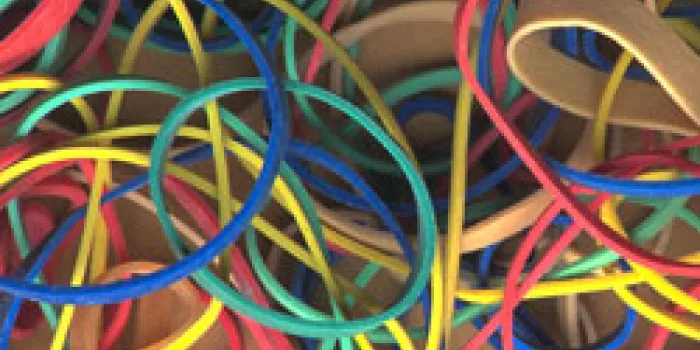Here’s a medical pop quiz.
The fibers that make up blood clots are stretchy like:
A. Play dough
B. Plastic bags
C. Rubber bands
To uncover the answer to questions about the flexibility of blood clots, a group of medical researchers studied the fibrin fibers that form the structural framework of a clot.
They started by building a dual microscope that allowed them to stretch a fibrin fiber and then see it. Next, they suspended individual fibers over ridges, “just a like a bridge over a gorge,” explains Martin Guthold, one of the researchers, and a physicist at Wake Forest University in Winston-Salem, North Carolina.
The researchers discovered that fibrin fibers are extremely extendable and elastic, just like a rubber band. (Give yourself a high five if you selected C. as the answer to the medical pop quiz.)
In fact, blood clot fibrin fibers can stretch more than four times their length before they break. And they can stretch three times their length and still return to their original shape without permanent damage. That’s something play dough and plastic bags could never do.
This particular study, published in Science magazine, (Liu W, et al. Fibrin fibers have extraordinary extensibility and elasticity. Science 2006; 313:634) was designed to help scientists understand more about the basics of clotting. “The ultimate goal in this kind of work is building a good model of a blood clot and to really be able to understand its mechanical behavior,” Guthold says. “We want to get a good foundation to understand why clots behave the way they do and why they break.”
This kind of work is important to help prevent dangerous blood clots from forming, and researchers also learned some interesting facts that could someday lead to a better understanding of certain types of hemophilia.
“As we know, people with bleeding disorders do not form strong clots and then those clots don’t stay in place,” notes Susan Lord, a pathologist at the University of North Carolina at Chapel Hill, and a study co-author. “It’s important to understand the strength of a clot in terms of preventing bleeding.”
For example, this study revealed that when fibrins are “cross-linked” they stretch more than when they are “uncross-linked.” The discovery is somewhat counterintuitive because a rubber tire (cross-linked) is less stretchy than a rubber band (uncross-linked).
This knowledge applies to patients with factor XIII deficiencies whose fibrin fibers lack the ability to cross-link during the clotting process.
Guthold says he also was surprised to learn that a clot can only be stretched two or three times its length, as opposed to the individual fibers that can be stretched four times their length. “The junctions of the fibers may be the weakest part of the clots, not the fibers themselves,” he says.
While the study’s implications for hemophilia are more long term, the information could be used to treat thrombosis, a condition in which a clot blocks the flow of blood through the circulatory system. A company developing a device to break up blood clots using ultrasound technology has expressed interest in the findings. “The company is trying to understand how much force you have to apply to fibers to break them up without damaging any other tissues or blood cells,” says Guthold.
For Lord, the experiment has sparked an interest in understanding more about the role of fibers in nature. For example, fibers hold ocean mussels onto rocks and help clams open and close their shells. “This brings to my mind questions about why it is so important that fibers, like those in blood clots, are both strong and elastic,” says Lord. “Understanding bleeding disorders is about more than just clot stability. It’s also about the process that happens after a clot is formed.”

